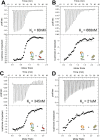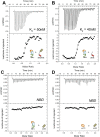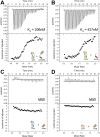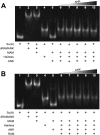Thermodynamic binding analysis of Notch transcription complexes from Drosophila melanogaster
- PMID: 25650119
- PMCID: PMC4420529
- DOI: 10.1002/pro.2652
Thermodynamic binding analysis of Notch transcription complexes from Drosophila melanogaster
Abstract
Notch is an intercellular signaling pathway that is highly conserved in metazoans and is essential for proper cellular specification during development and in the adult organism. Misregulated Notch signaling underlies or contributes to the pathogenesis of many human diseases, most notably cancer. Signaling through the Notch pathway ultimately results in changes in gene expression, which is regulated by the transcription factor CSL. Upon pathway activation, CSL forms a ternary complex with the intracellular domain of the Notch receptor (NICD) and the transcriptional coactivator Mastermind (MAM) that activates transcription from Notch target genes. While detailed in vitro studies have been conducted with mammalian and worm orthologous proteins, less is known regarding the molecular details of the Notch ternary complex in Drosophila. Here we thermodynamically characterize the assembly of the fly ternary complex using isothermal titration calorimetry. Our data reveal striking differences in the way the RAM (RBP-J associated molecule) and ANK (ankyrin) domains of NICD interact with CSL that is specific to the fly. Additional analysis using cross-species experiments suggest that these differences are primarily due to fly CSL, while experiments using point mutants show that the interface between fly CSL and ANK is likely similar to the mammalian and worm interface. Finally, we show that the binding of the fly RAM domain to CSL does not affect interactions of the corepressor Hairless with CSL. Taken together, our data suggest species-specific differences in ternary complex assembly that may be significant in understanding how CSL regulates transcription in different organisms.
Keywords: CSL; RBP-J; X-ray crystallography; isothermal titration calorimetry; notch signaling; protein−protein interactions; transcription.
© 2015 The Protein Society.
Figures






Similar articles
-
Structural and functional analysis of the repressor complex in the Notch signaling pathway of Drosophila melanogaster.Mol Biol Cell. 2011 Sep;22(17):3242-52. doi: 10.1091/mbc.E11-05-0420. Epub 2011 Jul 7. Mol Biol Cell. 2011. PMID: 21737682 Free PMC article.
-
Structure-function analysis of RBP-J-interacting and tubulin-associated (RITA) reveals regions critical for repression of Notch target genes.J Biol Chem. 2017 Jun 23;292(25):10549-10563. doi: 10.1074/jbc.M117.791707. Epub 2017 May 9. J Biol Chem. 2017. PMID: 28487372 Free PMC article.
-
Effects of Linker Length and Transient Secondary Structure Elements in the Intrinsically Disordered Notch RAM Region on Notch Signaling.J Mol Biol. 2015 Nov 6;427(22):3587-3597. doi: 10.1016/j.jmb.2015.09.001. Epub 2015 Sep 5. J Mol Biol. 2015. PMID: 26344835 Free PMC article.
-
The effects of conformational heterogeneity on the binding of the Notch intracellular domain to effector proteins: a case of biologically tuned disorder.Biochem Soc Trans. 2008 Apr;36(Pt 2):157-66. doi: 10.1042/BST0360157. Biochem Soc Trans. 2008. PMID: 18363556 Review.
-
CSL-Associated Corepressor and Coactivator Complexes.Adv Exp Med Biol. 2018;1066:279-295. doi: 10.1007/978-3-319-89512-3_14. Adv Exp Med Biol. 2018. PMID: 30030832 Review.
Cited by
-
Structure and Function of the Su(H)-Hairless Repressor Complex, the Major Antagonist of Notch Signaling in Drosophila melanogaster.PLoS Biol. 2016 Jul 12;14(7):e1002509. doi: 10.1371/journal.pbio.1002509. eCollection 2016 Jul. PLoS Biol. 2016. PMID: 27404588 Free PMC article.
-
Generation of New Hairless Alleles by Genomic Engineering at the Hairless Locus in Drosophila melanogaster.PLoS One. 2015 Oct 8;10(10):e0140007. doi: 10.1371/journal.pone.0140007. eCollection 2015. PLoS One. 2015. PMID: 26448463 Free PMC article.
-
Bivalent interaction through an intrinsically disordered linker promotes transcription activation complex assembly in Notch signaling.Proc Natl Acad Sci U S A. 2025 Jul 29;122(30):e2501607122. doi: 10.1073/pnas.2501607122. Epub 2025 Jul 25. Proc Natl Acad Sci U S A. 2025. PMID: 40711919
-
The CSL proteins, versatile transcription factors and context dependent corepressors of the notch signaling pathway.Cell Div. 2016 Sep 27;11:12. doi: 10.1186/s13008-016-0025-2. eCollection 2016. Cell Div. 2016. PMID: 27708688 Free PMC article. Review.
-
Control of transcriptional activity by design of charge patterning in the intrinsically disordered RAM region of the Notch receptor.Proc Natl Acad Sci U S A. 2017 Oct 31;114(44):E9243-E9252. doi: 10.1073/pnas.1706083114. Epub 2017 Oct 12. Proc Natl Acad Sci U S A. 2017. PMID: 29078291 Free PMC article.
References
-
- Fortini ME. Introduction—notch in development and disease. Semin Cell Dev Biol. 2012;23:419–420. - PubMed
-
- Liu J, Sato C, Cerletti M, Wagers A. Notch signaling in the regulation of stem cell self-renewal and differentiation. Curr Top Dev Biol. 2010;92:367–409. - PubMed
-
- Radtke F, Fasnacht N, Macdonald HR. Notch signaling in the immune system. Immunity. 2010;32:14–27. - PubMed
Publication types
MeSH terms
Substances
Grants and funding
LinkOut - more resources
Full Text Sources
Other Literature Sources
Molecular Biology Databases

